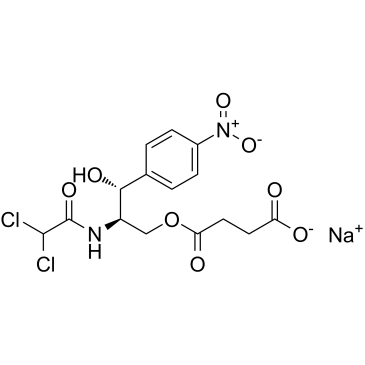Chloramphenicol sodium succinate

Chloramphenicol sodium succinate structure
|
Common Name | Chloramphenicol sodium succinate | ||
|---|---|---|---|---|
| CAS Number | 982-57-0 | Molecular Weight | 445.184 | |
| Density | N/A | Boiling Point | 716.3ºC at 760mmHg | |
| Molecular Formula | C15H15Cl2N2NaO8 | Melting Point | N/A | |
| MSDS | Chinese USA | Flash Point | 387ºC | |
| Symbol |

GHS08 |
Signal Word | Warning | |
|
The myelotoxicity of chloramphenicol: in vitro and in vivo studies: II: In vivo myelotoxicity in the B6C3F1 mouse.
Hum. Exp. Toxicol. 17(1) , 8-17, (1998) 1. Chloramphenicol continues to be widely used in many parts of the world despite its known haematotoxicity. Until now, elucidation of the mechanisms involved and any attempt at amelioration of the toxic effects have been hampered by the lack of an animal mod... |
|
|
A commercial enzyme immunoassay method (EMIT) compared with liquid chromatography and bioassay methods for measurement of chloramphenicol.
Clin. Chem. 34(9) , 1872-5, (1988) A new enzyme immunoassay method (EMIT; Syva Co.) was compared with conventional high-performance liquid chromatography (HPLC) and agar-diffusion bioassay methods for measurement of chloramphenicol in human serum. Forty-nine serum samples were assayed by each ... |
|
|
Chloramphenicol succinate, a competitive substrate and inhibitor of succinate dehydrogenase: possible reason for its toxicity.
Toxicol. In Vitro 18(4) , 441-7, (2004) From our previous study [Eur. J. Clin. Pharmacol. 56 (2000) 405] we hypothesized that chloramphenicol succinate (CAPS) may be a competitive substrate for succinate dehydrogenase (SDH). It may be oxidized by SDH to release chloramphenicol (CAP), which may inhi... |
|
|
Fluorometric quantitation of broth-cultured mycoplasmas by using alkaline ethidium bromide.
J. Clin. Microbiol. 31(5) , 1303-7, (1993) We developed a fluorometric system which does for broth-grown mycoplasmas what turbidimetric analysis does for broth-grown bacteria. It allows one to monitor the growth of broth-grown mycoplasmas at any interval desired. The entire procedure is quick, taking ... |
|
|
Metabolism of chloramphenicol succinate in human bone marrow.
Eur. J. Clin. Pharmacol. 56(5) , 405-9, (2000) The metabolism of chloramphenicol succinate (CAPS) by human bone marrow was studied in vitro using 75 marrow samples. Whole marrow samples were incubated with CAPS with or without reduced nicotinamide adenine dinucleotide phosphate for 1, 2 and 3 h at 37 degr... |
|
|
Haemotoxicity of chloramphenicol succinate in the CD-1 mouse and Wistar Hanover rat.
Hum. Exp. Toxicol. 18(9) , 566-76, (1999) 1. Chloramphenicol has been widely used in the treatment of serious infections including typhoid fever and meningitis. However, the drug is haemotoxic in man inducing firstly, a reversible, dose-dependent anaemia which develops during treatment, secondly, an ... |
|
|
Studies on the haemotoxicity of chloramphenicol succinate in the Dunkin Hartley guinea pig.
Int. J. Exp. Pathol. 83(5) , 225-38, (2002) In man, chloramphenicol (CAP), induces two major haemotoxic effects. First, a reversible, dose-related reticulocytopenia and anaemia developing during treatment. Second, a non-dose-related aplastic anaemia (AA), developing weeks after treatment, is often irre... |
|
|
Characterization of the myelotoxicity of chloramphenicol succinate in the B6C3F1 mouse.
Int. J. Exp. Pathol. 87(2) , 101-12, (2006) Chloramphenicol (CAP) is haemotoxic in man, inducing two types of toxicity. First, a dose-related, reversible anaemia with reticulocytopenia, sometimes seen in conjunction with leucopenia and thrombocytopenia; this form of toxicity develops during drug treatm... |
|
|
Alteration of hepatic carboxylesterase activity by soman: inhibition in vitro and enhancement in vivo.
Xenobiotica 19(1) , 115-21, (1989) 1. Hydrolysis of the drug esters procaine, chloramphenicol succinate, and prednisolone succinate was studied. Addition of soman to guinea pig liver microsomes caused a dose-dependent inhibition of hydrolysis of all three substrates; at the highest soman conce... |
|
|
Participation of macrophages in chloramphenicol-potentiated carrageenin-induced peritonitis in rats.
Braz. J. Med. Biol. Res. 26(5) , 497-507, (1993) 1. We investigated the possible potentiating effect of chloramphenicol succinate (30 mg/kg, every 12 h for 4 days, ip) on the response of polymorphonuclear neutrophils to carrageenin (150 micrograms, ip) or dextran (100 micrograms, ip) in the peritoneal cavit... |